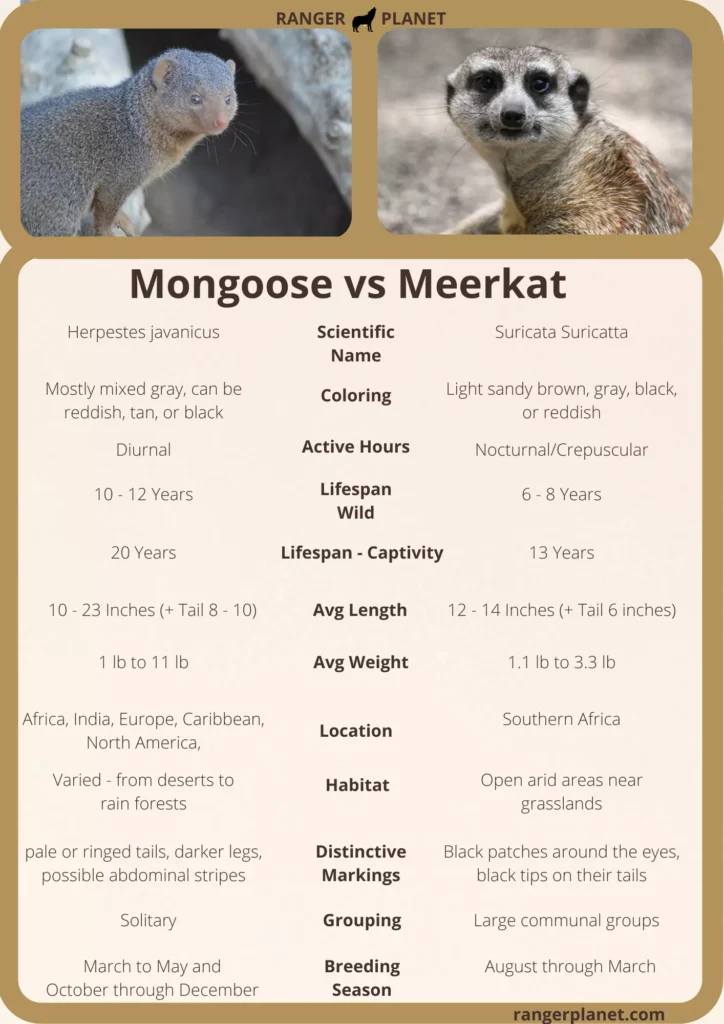Here we’re going to make it easier for you to tell the difference between mongoose vs meerkat. We’ll go over the key physical appearance, habitat, location, and other areas where they are both similar and different.
Here’s a summary, then we’ll get into more details…
Mongoose and Meerkats belong to the same family of Mongoose. The mongoose family Herpestidae includes small mostly omnivorous mammals, of which Meerkats are also weasel-like animals that are members of this family of mammals. They do however have some physical, and other distinct differences.
Let’s go on to discuss some aspects of both mongoose and meerkat to highlight the differences and similarities.
Mongoose vs Meerkat: Physical appearance
There are some physical differences between a mongoose and a meerkat. Mostly around coloring. Here’s the list of their key physical characteristics:
Mongoose:
- Weighs between 1 lb to 11 lb (490 grams to 5kg)
- Head and body length range from 10 to 23 inches (25 to 58 cm)
- The tail is usually around 8 to 10 inches (20 – 25 cm) long
- Rounded ears
- Color is usually a mixed gray, but can also be reddish, tan, black
- The ears are large and pointed
- Will stand on hind legs to keep a watch for prey
In terms of coloring, Mongoose has a wide range of colors. Many are grey tones through to brown, and a few species have markings such as ringed tails or paler colored tails, darker legs, and possible stripes around their abdomen.
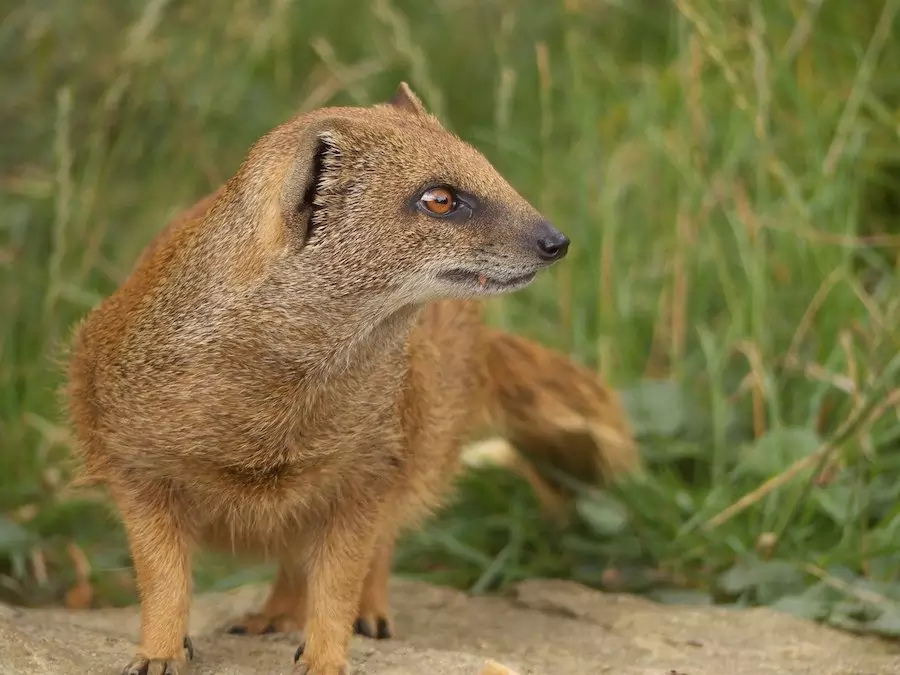
Meerkat:
- Weighs between 1.1 lb to 3.3 lb (around 0.5 and 1.5 kg)
- Head and body length range from 10 to 14 inches (25 to 35 cm)
- The tail is usually around 6 inches (15 cm) long
- Color is usually a light sandy brown, but can be gray, black, or reddish
- The ears are small and rounded
- Dark patches around the eyes for protection from the sun
- Dark tips to their tails
- Will stand on hind legs to keep watch for prey

If their physical traits seem very similar, that’s because Mongoose and Meerkats are not as different as you might think. They’re closely related in taxonomical terms.
Mongoose and Meerkat: Taxonomical connection
The mongoose and meerkat are both small mammals. They’re also both members of the family Herpestidae, but they belong to different genera.
Mongoose is in the genus Mongoose, while the Meerkat is in the genus Suricata. This is where the similarities diverge.
Mongoose:
Kingdom: Animalia
Phylum: Chordata
Class: Mammalia
Order: Carnivora
Suborder: Feliformia
Family: Herpestidae
Genus: Herpestes
Species: H javanicus
Meerkat:
Kingdom: Animalia
Phylum: Chordata
Class: Mammalia
Order: Carnivora
Suborder: Feliformia
Family: Herpestidae
Genus: Suricata
Species: S. suricatta
Mongoose vs Meerkat: Geography
There are a few key differences in the global location of each of these creatures.
Mongoose Locations:
Mongoose can be found predominantly in Africa and India. However, they are also found in some parts of Europe and in the Americas. Namely Hawaii, the Virgin Islands, and the Caribbean. The small Indian Mongoose is also now an invasive species in Texas.
Meerkat Locations:
Meerkats are located throughout southern Africa where habitats suit their needs. This includes areas of Botswana, Zimbabwe, and Mozambique. They can also be found in the Kalahari Desert in southern Africa
So on the subject of Mongoose vs Meerkat, this helps us identify which species it is a lot more accurately. The only overlap areas are in Africa. In other places, you will need to look in more detail at their physical and other traits.
So if you happen to live in, or visit Africa, then what habitat would you expect to find mongoose or meerkats living in? We’ll tackle that next.
Mongoose vs Meerkat: Habitat
Mongooses live in a wide variety of habitats, from deserts to rainforests, while meerkats live in open arid areas near grasslands.
They will also take to living near human settlements, while meerkats avoid humans as much as possible.
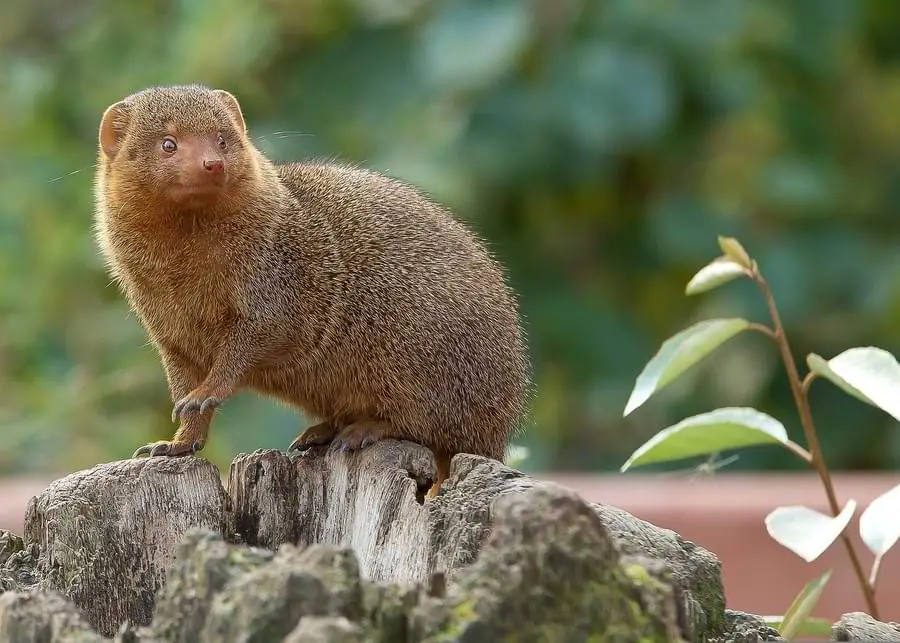
Mongoose vs Meerkat: Diet
Both mongooses and meerkats are omnivorous but are primarily carnivores in the balance of their diet. However, each does have subtle differences in their food preferences.
- Mongooses mostly eat small animals, such as rodents, frogs, lizards, fish, crabs, and birds, plus ground birds, occasional eggs, and some fruit.
- Meerkats mostly feed on insects, but they will also eat small mammals, lizards, snakes, scorpions, rodents, eggs, and fruits.
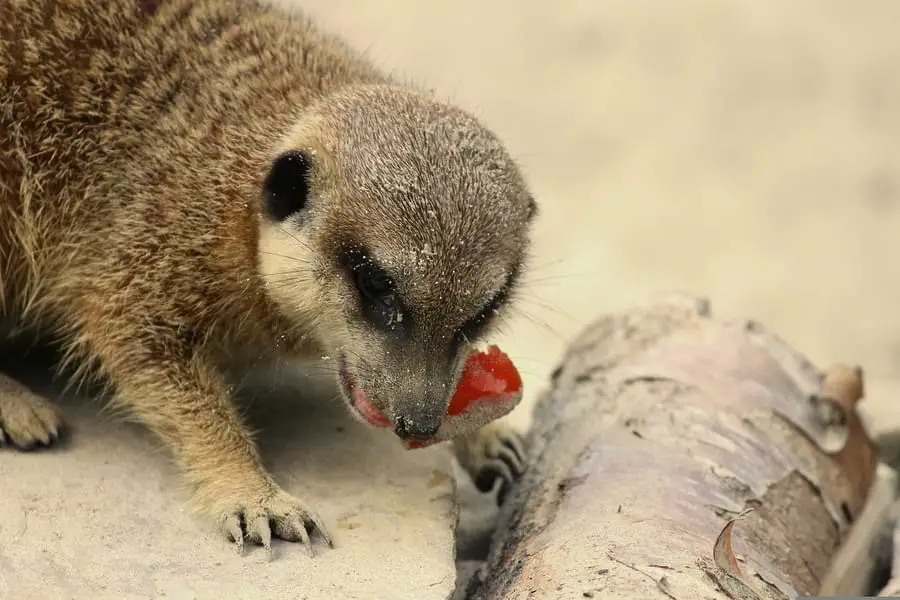
Mongoose vs Meerkat: Predators
Mongooses have a variety of predators, depending on which continent they live on, and the habitat they choose. Across all species, predators might include lions, leopards, hyenas, large birds of prey, and snakes.
Learn more about how dangerous mongooses are.
Meerkats are preyed upon predominantly by birds of prey Meerkats are often in open plains, so their main threats are from birds of Prey, including hawks and eagles. On the ground, they are preyed upon by snakes. But such as eagles and hawks. snakes, jackals, eagles, and hawks.
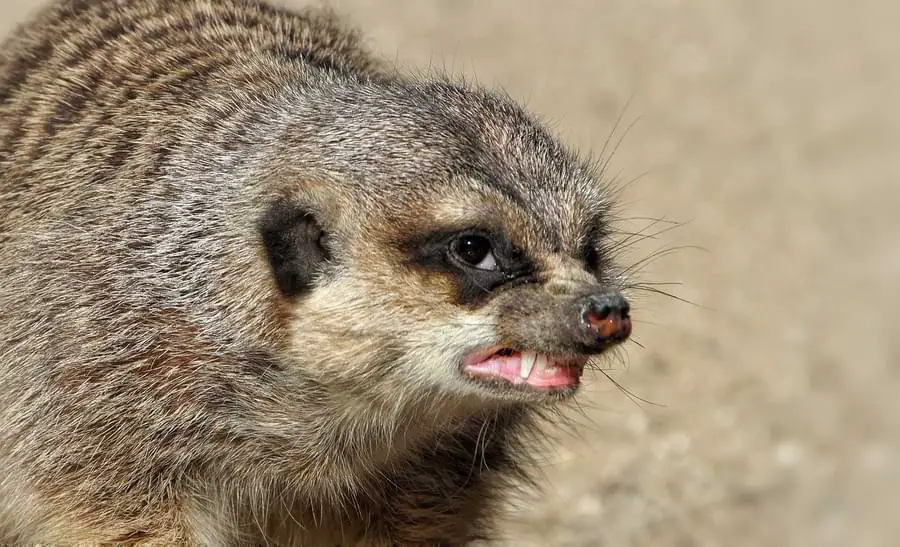
Mongoose vs Meerkat: Sociability
Here there are some distinct differences when identifying mongoose or meerkat.
Mongooses are solitary animals, while meerkats live in colonies of up to 50 individuals.
They are mostly active during the day, while meerkats are active mostly at night.
Mongooses will attack predators or other animals that they perceive as a threat to their territory or themselves, while meerkats typically rely on numbers and teamwork to defend against predators.
Socially toward each other, mongooses are aggressive and territorial while meerkats are communal and cooperative, even using sounds to communicate with each other.
Meerkats will stand guard and alert other members to predators – using a “dance”, or a “stretch” to indicate aggression or submission. They will also communicate for help, or to share any found food resources.
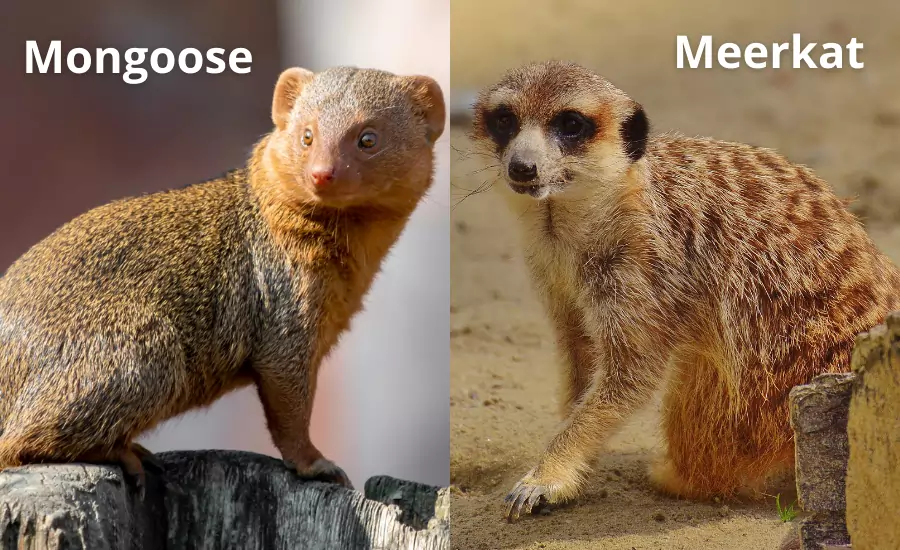
Mongoose vs Meerkat: Reproduction
Both mongooses and Meerkats also have very similar patterns in terms of birthing and rearing their young.
Mongoose reproduction:
Mating typically takes place from March to May and from October through December.
Female Mongooses have a gestation period of around 3 months and give birth to 2 – 5 young. Giving birth to 2 to 3 litters per year.
Mongoose pups are born inside a burrowed den and are weaned at around 3 months. They are born without sight or hearing but develop these senses, along with their fur within the first few weeks of life before venturing beyond the safety of the den.
After another two to three weeks, they will begin to hunt alongside their mother.
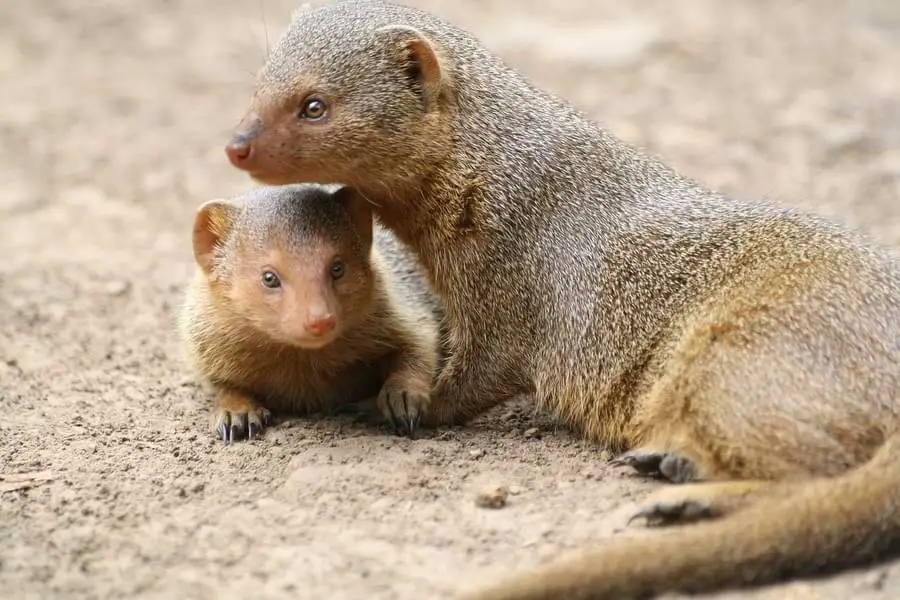
Meerkat reproduction:
The warm rainy season is typically mating season, from August through March.
Female meerkats have a gestation period of about 2.5 to 3 months and also give birth to 2 – 5 young.
She can have several litters in one year. and will typically give birth between November and March during the rainy season when food is in abundance.
Much like Mongoose, pups are born inside a burrowed den, with their eyes and ears closed and with only sparse hair. They weigh just 0.9 to 1.3 ounces at birth.
However, their eyes will open after 2 weeks, and they will wean off milk at around three weeks. They will venture out from the den quite quickly, at around 4 weeks of age.
At around a year and a half old, they will reach sexual maturity.
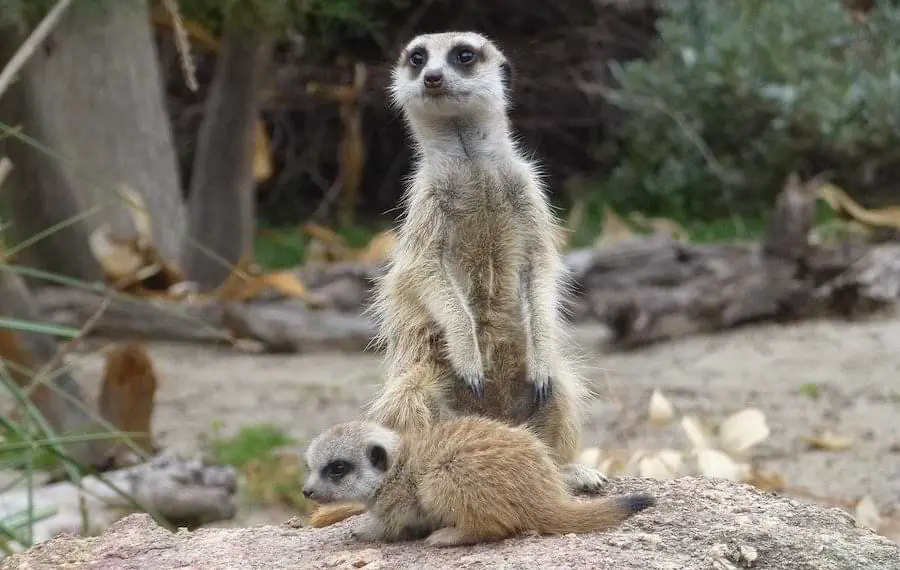
Mongoose vs Meerkat: Life Span
Mongooses can live 10 to 12 years in the wild, and in captivity, they can live up to 20 years.
Meerkats will generally live for about 6 – 8 years in the wild and up to 13 years in captivity but have been known to live up to 20 years.
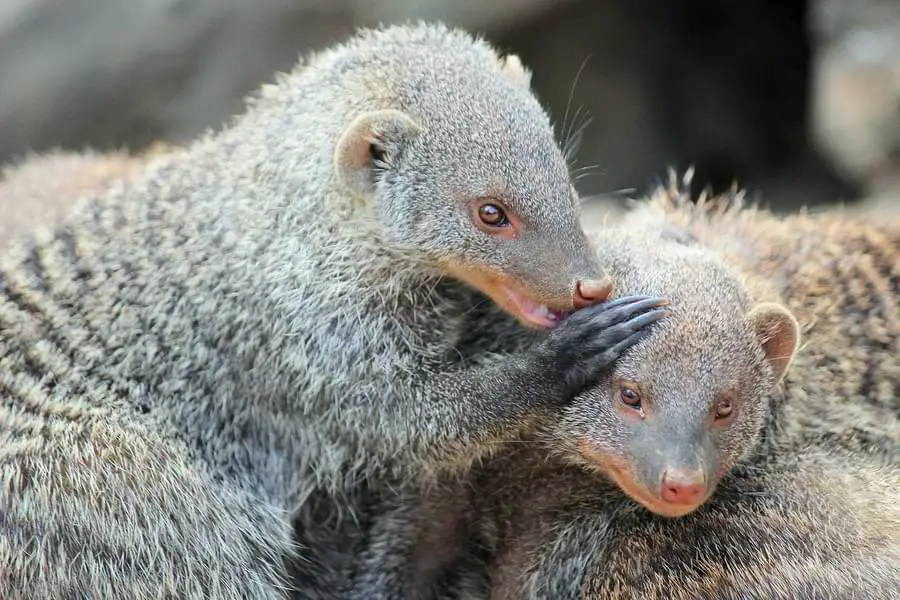
Mongoose vs Meerkat: Conservation Status
The mongoose’s adaptable approach to habitat means they are mostly considered to be “least concern”. But the status of species may vary. The dwarf mongoose is classed as “least concern”, while the Madagascar Mongoose is “endangered”, mostly due to habitat loss and hunting.
Overall, there are no major threats to the population levels for meerkats. According to the IUCN‘s red list, meerkats are classed as “least concern”.
More wildlife help…
We hope that helps to answer the question of the differences between mongooses and meerkats. There’s also a handy shareable reference sheet you can refer to below.
